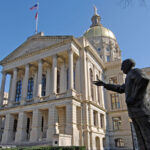- Current Events Nebraska Rejects Winner-Take-All Proposal
- Citizenship Voting Under Age 18
- Citizenship Citizenship in Action
- Democratic Party Biden’s and Trump’s Recent Primary Results
- Elections Trump and Biden Win South Carolina and Michigan Primaries
- Democratic Party Trump and Biden Win Big in Early February Contests

The Science of Victory
Scientists and the regulators in the federal government often seem to be at odds with each other. President Trump, for example, has questioned the dangers of climate change and has appointed other politicians and individuals who have also questioned climate change to lead the Environmental Protection Agency (EPA). Federal funding for science is also falling sharply. Now, many scientists have decided to fight back. But how?
By running for office. But do scientists have what it takes to win elections and try to speak their views in the halls of government? Here, Election Central takes a look.
What Are Their Strengths?
Last year, over 7,000 people with math and science backgrounds indicated an interest in running for elected office, from the local level all the way up to the U.S. Congress in Washington, D.C. Should they decide to run, these candidates could have some advantages over mainstream politicians. Studies show that many Americans tend to trust someone with a science (especially medical science) background far more than they do someone in politics. And people who are strong in math and science often have a natural knack for the statistics and data analysis part of campaigning.
What Are Their Weaknesses?
Unfortunately, where scientists sometimes fall short is when they place more stock in numbers and data than they do in personal stories. This can be a disadvantage when giving political speeches, which are more about convincing people to like and trust you as a candidate. A rational, analytical series of campaign arguments that focus on hard facts and figures can turn some voters away.
To address this gap, a chemist named Shaughnessy Naughton formed a group called 314 Action, a political action committee with the goal of helping other scientists run for office. (314 are the first three digits of the irrational mathematic number known as “pi.”) The group hosts a series of web trainings, some led by a public-speaking coach, that help potential candidates understand the importance of forming these critical interpersonal relationships.
Taking to the Streets
Running for elected office is not the only way that scientists have been fighting to get their message out. On April 22 of last year–Earth Day–The March for Science was held in Washington, D.C. and in more than 600 other cities around the world. More than a million people participated. Over 230,000 people remain on the group’s mailing list, and tens of thousands more follow on social media. Plans are already underway for this year’s march, which will be on April 14.
The organizers of the march have expanded and diversified their efforts this year. Their goal is to turn the momentum behind the march into a full-fledged movement. To this end, they are hosting a three-day workshop in Chicago this month, called “The March for Science Summit,” which focuses on community and grassroots organizing and volunteer recruitment. A monthly newsletter encourages fellow scientists and science supporters to speak out to their government representatives and state their opinions on issues including agriculture, the environment, health care, gun violence research, and more. The group is also actively seeking grants to help them spread the word, as well as registering voters.


